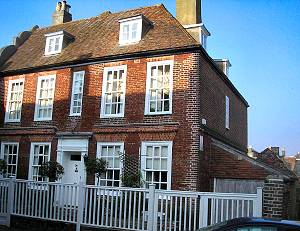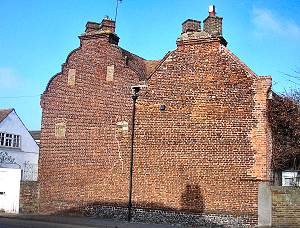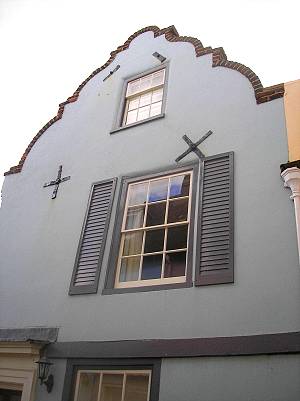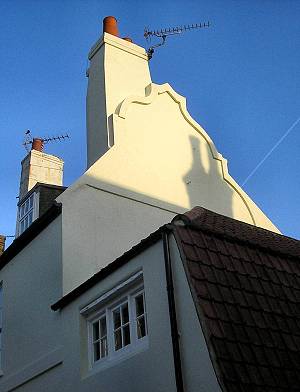The Dutch and Flemish Gables of Deal
Gordon Taylor, a past Chairman of the Isle of Thanet Archaeological Society, spotted Arthur Percival's article on east Kent's Dutch gables on this website and got in touch. He kindly offered to produce an article focusing on Deal's curvilinear gables - something only briefly dealt with in Arthur's piece. Although not always easy to see, Deal has retained more of these attractive features than most neighbouring towns as Gordon Taylor now reveals....
Among the many claims to fame that Deal might have, one of the better but little known ones is the number of houses with Dutch or Flemish gables – those attractive curling edges to the side walls of properties – all in a comparatively compact area.
Having undertaken a study of the shaped gables of houses from the 16th, 17th and 18th centuries commonly known as Dutch or Flemish gables that occur mostly down the eastern counties of England, I naturally turned my attention to Deal. I had read in the now defunct East Kent Critic back in the 1970’s of the number of houses with curvilinear gables in and around what was known as "Dutch Corner" in Deal.
It turned out that Deal in common with The Rows at Great Yarmouth in Norfolk didn’t fit in with the pattern of the gables elsewhere in Kent and East Anglia. These were mostly attributable to fashion - brick extensions on older timber framed houses – and a few possibly to traders or drainage engineers or the Queen Anne style around 1700 or just after. I had previously believed they were built by religious refugees from the Netherlands – not so. Those in Deal and Great Yarmouth were apparently mostly built by or for fishermen and those working in connection with the sea, and in similar fashion.
Deal is fortunate in retaining at least 26 but has lost probably as many again, whereas Great Yarmouth has lost all but one or two. PM Williamson in the East Kent Critic stated that the area of the car park (created through WW II bombing) at the southern end of Middle Street had many Dutch cottages (perhaps including those with the small Dutch bricks but straight gables) and certainly Middle Street forms a ‘spine’ off which nearly all the others occur.
Queen Anne House 1710 (below) in Middle Street and Jenkins Well built in 1694 in Upper Deal (below) fit in with the rest of east Kent’s examples; there were two others in Upper Deal but they have gone unfortunately. The date of the remainder can most likely be put in the second half of the 17th century or early 18th as there was a building boom after the ending of the commonwealth and restoration of the monarchy.

Queen Anne House, Middle Street

Jenkin’s Well, Upper Deal
Unfortunately, many of the houses with curvilinear gables in Deal have not been maintained well in the past. But since the "Council for British Archaeology in 1965 recognised Deal as one of seven towns in Kent as having historic centres requiring particularly careful treatment and the Middle Street area of Deal was designated as a Conservation Area under the Civic Amenities Act 1967”¹ (the first area in Kent) the properties are increasingly being sympathetically maintained and restored. Some have been "improved" to keep up with fashion and their origins have been masked.
The cottage gables tend to be of a pattern i.e. a round or segmental pediment with an ogee (a slight S shape) curve under, a step then a convex curve (below) although there are some that are different. Two have a pediment that is only found in, or near Thanet (NE Kent) those being 10, Chapel Street (below) and an outhouse behind the Queen Anne House in Middle Street. Two have a chimney in place of the pediment whilst at least three have lost their pediment altogether – Chapel Street again, Golden and Silver Streets. Most are rendered; those that aren’t are built of brick and nearly all have one or more dormer windows in the roof and are two storey. None have the date on and only two have wall anchors – features sometimes used to show an affinity with the Netherlands.

Typical gable at 12, Dolphin Street

Showing the Thanet pediment
Because of the charming narrowness of the streets in this area, which fortunately deters traffic, some of the gables are difficult to see as, unlike in the Netherlands, they don’t face the street with only a couple of exceptions; see 12 Dolphin Street. Whilst Sandwich has a few remnants, only Margate and Ramsgate can approach Deal for the number of these delightful additions to Kent’s heritage.
© Gordon Taylor. Isle of Thanet Archaeological Society.
Reference: ¹ Deal, Middle Street Conservation Area – An Architectural Appraisal by R. G. Clarke Cty Planning Officer, Kent KCC 1971.